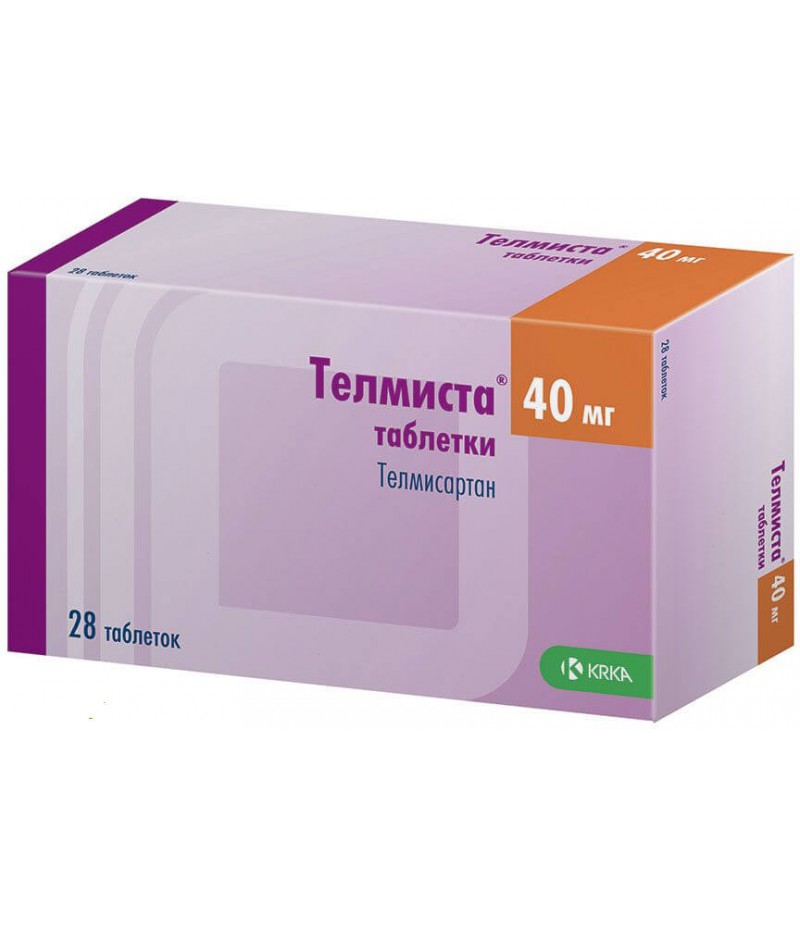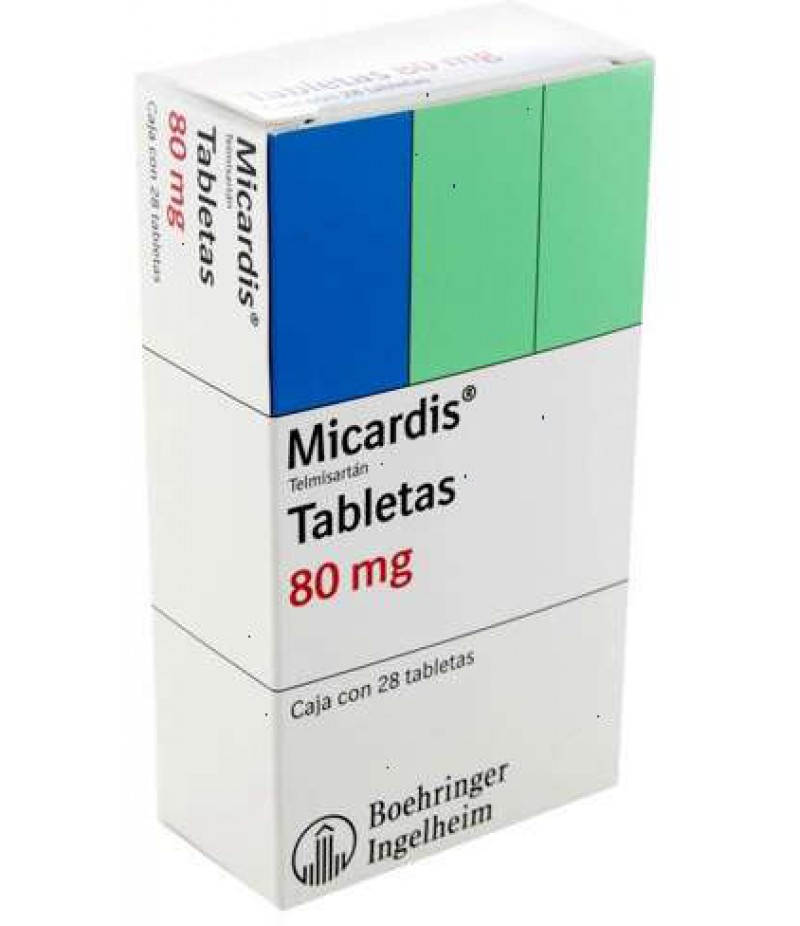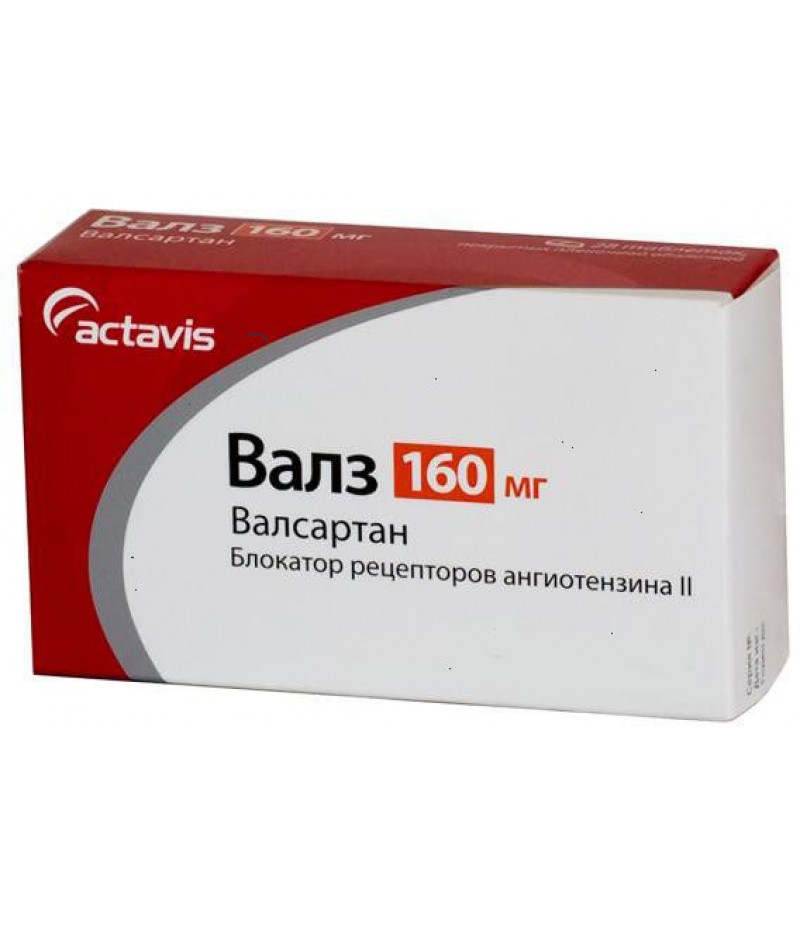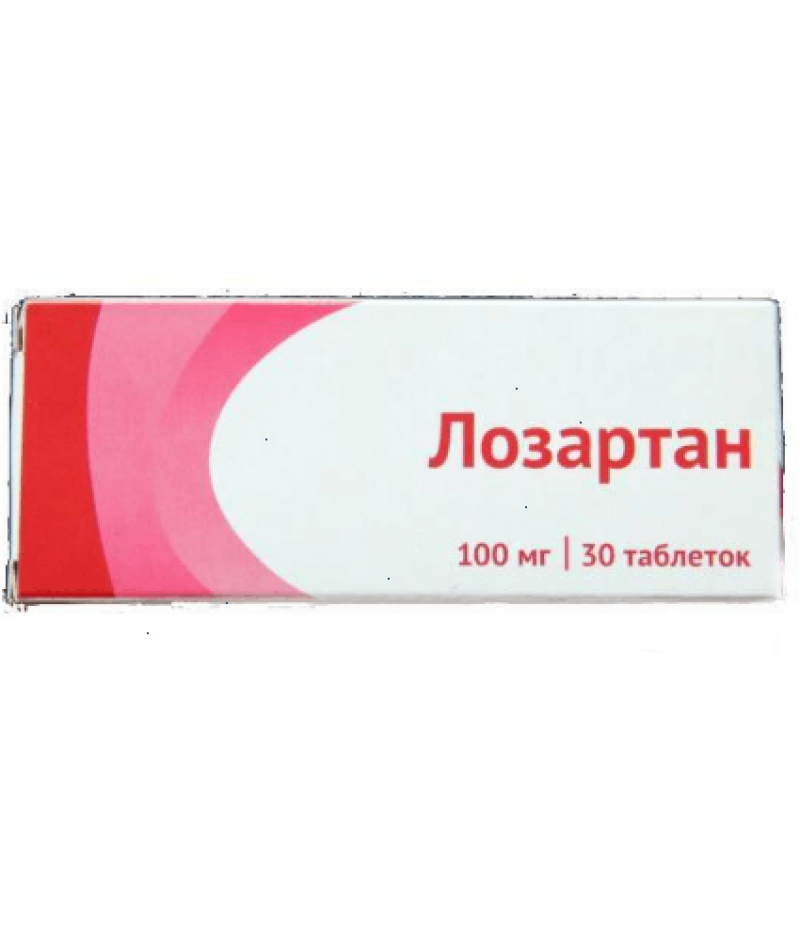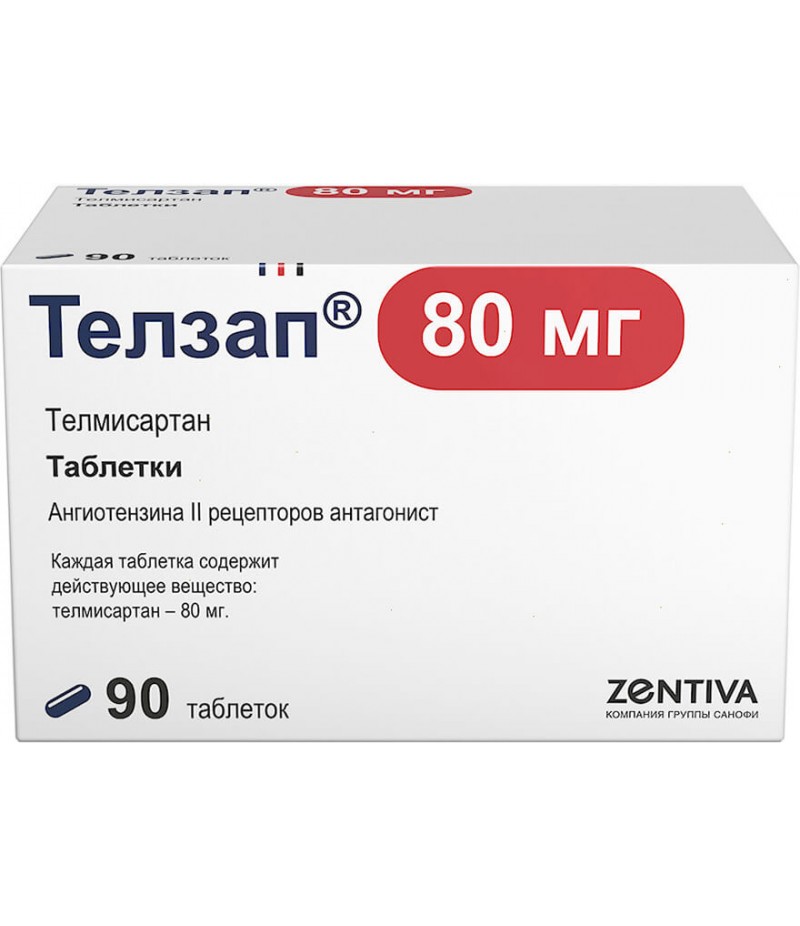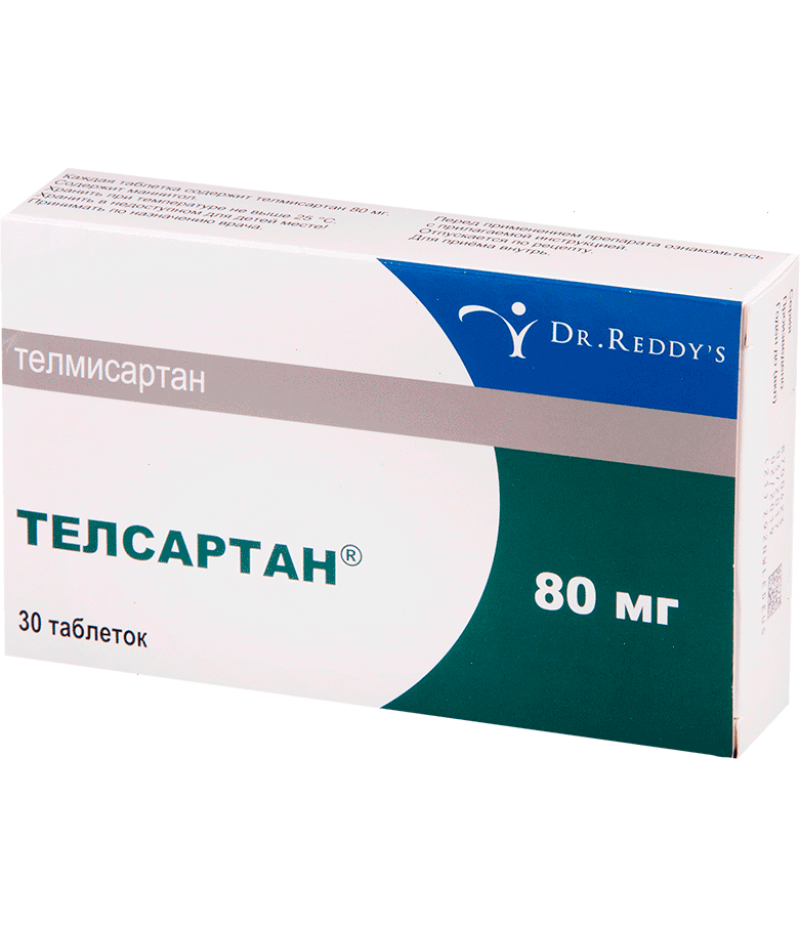Telmista tabs 40mg #28
- $18.25
- 3 or more $18.15
- Availability:In Stock
Telmista instructionYou can buy Telmista hereCompositionon 1 tablet of 20 mg / 40 mg / 80 mg:Active ingredient: Telmisartan 20.00 mg / 40.00 mg / 80.00 mgExcipients: meglumine, sodium hydroxide, iovidone-K30, lactose monohydrate, ..
Tags: tabs
Telmista instruction
You can buy Telmista here
Composition
on 1 tablet of 20 mg / 40 mg / 80 mg:
Active ingredient: Telmisartan 20.00 mg / 40.00 mg / 80.00 mg
Excipients: meglumine, sodium hydroxide, iovidone-K30, lactose monohydrate, sorbitol (E420), magnesium stearate
Description
20 mg tablets:
Round tablets of white or almost white color.
40 mg tablets:
Oval, biconvex tablets of white or almost white color.
80 mg tablets:
Capsule-shaped, biconvex tablets of white or almost white color.
Pharmacotherapeutic group: Angiotensin II receptor antagonist (APA II)
ATX Code: C09CA07
Pharmacodynamics
Telmisartan is a specific ARA II (type AT1), effective when taken orally. It has a high affinity for the AT1 subtype of angiotensin II receptors, through which the action of angiotensin II is realized. Displaces angiotensin II from its association with the receptor, not having the action of an agonist on this receptor. Telmisartan binds only to the angiotensin II receptor subtype AT1. Communication is long lasting. It has no affinity for other receptors, including AT2 receptors and other less studied angiotensin receptors. The functional significance of these receptors, as well as the effect of their possible over-stimulation with angiotensin II, the concentration of which increases with the use of telmisartan, has not been studied. Reduces the concentration of aldosterone in the blood plasma, does not inhibit renin in the blood plasma and does not block the ion channels. Telmisartan does not inhibit angiotensin-converting enzyme (ACE) (kininase II) (an enzyme that also destroys bradykinin). This avoids the side effects associated with the action of bradykinin (for example, a dry cough).
Essential hypertension
In patients with telmisartan in a dose of 80 mg completely blocks the hypertensive effect of angiotensin II. The onset of the antihypertensive effect occurs within 3 hours after the first dose of telmisartan. The effect of the drug lasts for 24 hours and remains significant up to 48 hours. A pronounced antihypertensive effect usually develops after 4-8 weeks of regular intake of telmisartan.
In patients with arterial hypertension, telmisartan reduces systolic and diastolic blood pressure (BP), without affecting the heart rate (HR).
In the case of abrupt cancellation of telmisartan, blood pressure gradually returns to the original level without the development of the "cancellation" syndrome.
As shown by the results of comparative clinical studies, the antihypertensive effect of telmisartan is comparable to the antihypertensive effect of drugs of other classes (amlodipine, atenolol, enalapril, hydrochlorothiazide, and lisinopril). The incidence of dry cough was significantly lower compared with the use of telmisartan, in contrast to ACE inhibitors.
Prevention of cardiovascular diseases
In patients aged 55 years and older with ischemic heart disease (CHD), stroke, transient ischemic attack, peripheral artery disease, or complications of type 2 diabetes (for example, retinopathy, left ventricular hypertrophy, macro- or microalbuminuria), anamnesis the risk of cardiovascular events, telmisartan had an effect similar to that of ramipril in reducing the combined end point: cardiovascular mortality, from non-fatal myocardial infarction, Ulta without death and hospitalization for congestive heart failure.
Telmisartan was as effective as ramipril in reducing the frequency of secondary points: cardiovascular mortality, non-fatal myocardial infarction.
Dry cough and angioedema were less frequently described in patients receiving telmisartan as opposed to ramipril, while arterial hypotension occurred more frequently in patients receiving telmisartan.
Patients of childhood and adolescence
The safety and efficacy of telmisartan in children and adolescents under 18 years of age have not been established.
Pharmacokinetics
When ingestion is rapidly absorbed from the gastrointestinal tract (GIT). Bioavailability - 50%. The decrease in AUC (area under the concentration-time curve) with simultaneous use of telmisartan with food intake varies from 6% (at a dose of 40 mg) to 19% (at a dose of 160 mg). After 3 hours after administration, plasma concentration levels out, regardless of the time of the meal. There is a difference in plasma concentrations in men and women. The maximum concentration (Cmax) in the blood plasma and AUC in women compared with men were higher by approximately 3 and 2 times, respectively (without a significant effect on efficacy). Communication with plasma proteins is 99.5%, mainly with albumin and alpha-1 glycoprotein.
The average value of the apparent volume of distribution in the equilibrium concentration is 500 l. Metabolized by conjugation with glucuronic acid. Metabolites are pharmacologically inactive. The half-life (T1 / 2) is more than 20 hours. Excreted mainly through the intestines unchanged and the kidneys - less than 2% of the dose. Total plasma clearance is high (900 ml / min) compared with the “hepatic” blood flow (about 1500 ml / min).
Pharmacokinetics in selected groups of patients
Elderly patients
The pharmacokinetics of telmisartan in elderly patients does not differ from the pharmacokinetics in young patients. Dose adjustment is not required.
Patients with renal failure
Changing the dose in patients with renal insufficiency is not required, including patients on hemodialysis.
Telmisartan is not removed by hemodialysis.
Patients with liver failure
In patients with mild and moderate hepatic impairment (Child-Pugh class A and B), the daily dose of the drug should not exceed 40 mg.
Pediatric use
The main pharmacokinetics of telmisartan in children aged 6 to 18 years after taking telmisartan at a dose of 1 mg / kg or 2 mg / kg for 4 weeks, in general, are comparable with those obtained in the treatment of adult patients, and confirm the nonlinearity telmisartan pharmacokinetics, especially for Cmax.
Indications for use
Essential hypertension.
Reducing mortality and cardiovascular disease in adult patients:
with cardiovascular diseases of atherothrombotic genesis (ischemic heart disease, stroke, or peripheral arterial disease in the history of anemnes);
with type 2 diabetes mellitus with target organ damage.
Contraindications for Telmista
Hypersensitivity to the active substance or excipients of the drug.
Pregnancy.
Breastfeeding period.
Obstructive diseases of the biliary tract.
Severe abnormal liver function (Child-Pugh class C).
Simultaneous use with aliskiren in patients with diabetes mellitus or moderate and severe renal insufficiency (glomerular filtration rate (GFR) <60 ml / min / 1.73 m2 of body surface area).
Fructose or lactose intolerance, lactase deficiency, glucose-galactose malabsorption syndrome (Telmista contains lactose and sorbitol [E420]).
Age up to 18 years (efficacy and safety have not been established).
Carefully
Bilateral renal artery stenosis or single kidney artery stenosis.
Impaired liver and / or kidney function (see section "Special Instructions").
Reduction in circulating blood volume (BCC) due to previous diuretic therapy, restriction of salt, diarrhea or vomiting.
Hyponatremia.
Hyperkalemia.
Conditions after kidney transplantation (no experience).
Chronic heart failure (CHF).
Stenosis of the aortic and / or mitral valve.
Hypertrophic obstructive cardiomyopathy (GOKMP).
Primary hyper aldosteronism (efficacy and safety have not been established).
Use in patients of the Negroid race.
Use during pregnancy and breastfeeding
Pregnancy
Use of the drug Telmista is contraindicated in pregnancy. The use of ARA II in the first trimester of pregnancy is not recommended, these drugs should not be used during pregnancy. When diagnosing pregnancy, Telmista should be discontinued immediately. If necessary, an alternative antihypertensive therapy should be prescribed (other classes of antihypertensive drugs allowed for use during pregnancy).
The use of ARA II in the second and third trimesters of pregnancy is contraindicated. In preclinical studies of telmisartan, no teratogenic effects have been identified, but fetotoxicity has been established. It is known that the use of ARA II in the second and third trimesters of pregnancy causes fetotoxicity in a person (decreased renal function, oligohydramnios, delayed ossification of the fetal bones), as well as neonatal toxicity (renal failure, arterial hypotension, hyperkalemia). Patients planning a pregnancy should be given alternative therapy. If nevertheless, ARA II was used in the second and third trimesters of pregnancy, then an ultrasound examination of the kidneys and bones of the fetal skull should be performed.
Newborns whose mothers took the drug ARA II during pregnancy should be monitored, because the development of arterial hypotension in the newborn is possible.
Breastfeeding period
Information on the use of telmisartan during breastfeeding is not available. Taking Telmista during breastfeeding is contraindicated (see section “Contraindications”); an alternative antihypertensive drug should be used with a more favorable safety profile, especially when feeding a newborn or premature baby.
Studies on the effect on human fertility have not been conducted.
Dosage and administration
Inside, once a day, squeezed fluid, regardless of meal times.
Essential hypertension
The initial recommended dose of Telmista is 1 tablet (40 mg) once a day. Some patients may be effective in taking 20 mg per day. In cases where the therapeutic effect is not achieved, the maximum recommended dose of Telmista can be increased to 80 mg once a day. As an alternative, Telmista can be taken in combination with thiazide diuretics, for example, hydrochlorothiazide, which, when used simultaneously, had an additional angi-hypertensive effect. When deciding whether to increase the dose, it should be taken into account that the maximum anti-hypertensive effect is usually achieved within 4-8 weeks after the start of treatment.
Reduced mortality and cardiovascular disease
The recommended dose is 1 tablet of Telmista 80 mg once a day. In the initial period of treatment, additional correction of blood pressure may be required.
Renal dysfunction
Experience with telmisartan in patients with severe renal failure or patients on hemodialysis is limited.
These patients recommended a lower initial dose of 20 mg per day (see section "Special instructions"). For patients with mild and moderate renal impairment, dose adjustment is not required.
Concomitant use of Telmista with aliskiren is contraindicated in patients with renal insufficiency (GFR less than 60 ml / min / 1.73 m2 of body surface area) (see section “Contraindications”).
The simultaneous use of the drug Telmista with ACE inhibitors is contraindicated in patients with diabetic nephropathy (see section "Contraindications").
Liver dysfunction
Telmista is contraindicated in patients with severe hepatic insufficiency (Child-Pugh class C) (see the “Contraindications” section). In patients with mild and moderate hepatic insufficiency (class A and B according to Child-Pyo classification, respectively), the drug is prescribed with caution, the dose should not exceed 40 mg once a day (see section “With caution”).
Elderly patients
Elderly patients do not require dose adjustment.
Children and adolescents
The use of the drug in children and adolescents under 18 years of age is contraindicated due to the lack of data on safety and efficacy (see section "Contraindications").
Side effect
According to the World Health Organization (WHO), undesirable effects are classified according to the frequency of their development as follows: very often (≥ 1/10), often (from ≥ 1/100 to <1/10), infrequently (from ≥ 1 / 1,000 to <1/100), rarely (from ≥ 1 / 10,000 to <1 / 1,000), very rarely (<1 / 10,000), the frequency is unknown - according to the available data it was not possible to establish the frequency of occurrence. Within each group, according to the frequency of occurrence, undesirable reactions are presented in order of decreasing severity.
Infectious and parasitic diseases
uncommon: urinary tract infections, including cystitis, upper respiratory tract infections, including pharyngitis and sinusitis;
rarely: sepsis, including fatal.
Violations of the blood and lymphatic system
infrequently: anemia;
rarely: eosinophilia, thrombocytopenia.
Immune system disorders
seldom: anaphylactic reaction, hypersensitivity.
Metabolic and nutritional disorders
infrequently: hyperkalemia;
rarely: hypoglycemia (in patients with diabetes).
Mental Disorders
infrequently: insomnia, depression;
rarely: anxiety.
Nervous system disorders
infrequently: fainting;
rarely: drowsiness
Violations by the organ of vision
rarely: visual disturbances.
Disturbances from an organ of hearing and labyrinth disturbances
infrequently: vertigo.
Heart disorders
infrequently: bradycardia;
seldom: tachycardia.
Vascular disorders
infrequently: pronounced decrease in blood pressure, orthostatic hypotension.
Disorders of the respiratory system, chest and mediastinum
infrequently: shortness of breath, cough;
very rare: interstitial lung disease.
Disorders of the gastrointestinal tract
infrequently: abdominal pain, diarrhea, dyspepsia, flatulence, vomiting;
rarely: dryness of the oral mucosa, discomfort in the stomach, a violation of taste sensations.
Disorders of the liver and biliary tract
rarely: liver dysfunction / liver damage.
Violations of the skin and subcutaneous tissues
infrequently: pruritus, hyperhidrosis, skin rash;
rarely: angioedema (also fatal), eczema, erythema, urticaria, drug rash, toxic skin rash.
Disorders of the musculoskeletal and connective tissues infrequently: back pain (ischialgia), muscle spasms, myalgia;
seldom: arthralgia, pain in the extremities, pain in the tendons (tendenitis-like syndrome).
Kidney and urinary tract disorders
infrequently: impaired renal function, including acute renal failure.
General disorders and disorders at the site of administration
infrequently: chest pain, asthenia (weakness);
seldom: flu-like syndrome.
Laboratory and instrumental studies
infrequently: increased plasma creatinine concentration;
rarely: a decrease in hemoglobin, an increase in the concentration of uric acid in the blood plasma, an increase in the activity of liver enzymes and creatine phosphokinase (CK) in the blood plasma.
Overdose with Telmista
Symptoms: The most pronounced manifestations of overdose were a pronounced decrease in blood pressure and tachycardia, also reported bradycardia, dizziness, increased serum creatinine concentration and acute renal failure.
Treatment: Telmisartan is not excreted by hemodialysis. Patients should be carefully monitored and symptomatic as well as supportive treatment should be carried out. The approach to treatment depends on the time elapsed after taking the drug, and the severity of symptoms. Recommended interventions include provoking vomiting and / or gastric lavage, it is advisable to receive activated charcoal. Electrolyte levels and plasma creatinine levels should be regularly monitored. When a pronounced decrease in blood pressure occurs, the patient should take a horizontal position with the legs elevated, and it is necessary to quickly fill in the volume of the BCC and electrolytes.
Interaction with other drugs
Double blockade of the renin-angiotezin-aldosterone system (RAAS) Concomitant use of telmisartan with aliskiren is contraindicated in patients with diabetes or renal insufficiency (GFR less than 60 ml / min / 1,732 m of body surface area) and is not recommended for other patients.
Simultaneous use of telmisartan and ACE inhibitors is contraindicated in patients with diabetic nephropathy (see section "Contraindications"). Data from clinical studies have shown that double blockade of the RAAS due to the combined use of ACE inhibitors, APAII or aliskiren is associated with an increased incidence of adverse events, such as arterial hypotension, hyperkalemia and renal impairment (including acute renal failure) compared to using only one drug, acting on the raas.
The risk of developing hyperkalemia may increase with simultaneous use with other drugs that can cause hyperkalemia (potassium-containing dietary supplements and salt substitutes containing potassium, potassium-sparing diuretics [for example, spironolactone, eplerenone, triamterene, or amiloride], nonsteroidal anti-inflammatory drugs, [non-steroidal drugs] [] cyclooxygenase-2 (COX-2) inhibitors, heparin, immunosuppressants [cyclosporine or tacrolimus], and trimethoprim). If necessary, against the background of documented hypokalemia, the simultaneous use of drugs should be carried out with caution and regularly monitor the content of potassium in the blood plasma.
Digoxin
With simultaneous use of telmisartan with digoxin, a mean increase in Cmax of digoxin in plasma was noted by 49% and a minimum concentration by 20%. At the beginning of treatment, when selecting a dose and stopping treatment with telmisartan, the concentration of digoxin in the blood plasma should be carefully controlled to maintain it within the therapeutic range.
Potassium-sparing diuretics or potassium-containing dietary supplements
ARA II, such as telmisartan, reduces the potassium loss caused by diuretics. Potassium-sparing diuretics, for example, spironolactone, eplerenone, triamterene or amiloride, potassium-containing dietary supplements or salt substitutes can lead to a significant increase in plasma potassium. If concomitant use is indicated, since there is documented hypokalemia, they should be used with caution and against the background of regular monitoring of potassium in the blood plasma.
Lithium preparations
With simultaneous use of lithium preparations with ACE and APA II inhibitors, including telmisartan, there was a reversible increase in plasma concentrations of lithium and its toxic effect. If necessary, the use of this combination of drugs is recommended to carefully monitor the concentration of lithium in the blood plasma.
NSAIDs
NSAIDs (i.e., acetylsalicylic acid in doses used for anti-inflammatory treatment, COX-2 inhibitors and non-selective NSAIDs) can weaken the antihypertensive effect of ARA II. In some patients with impaired renal function (for example, in patients with dehydration, elderly patients with impaired renal function), simultaneous use of APA II and cyclooxygenase-2 depressant drugs can lead to further deterioration of renal function, including the development of acute renal failure, which is usually reversible. Therefore, the simultaneous use of drugs should be carried out with caution, especially in elderly patients. Adequate fluid intake should be ensured, in addition, at the beginning of simultaneous use and periodically thereafter, kidney function indicators should be monitored.
Diuretics (thiazide or "loop")
Previous treatment with high doses of diuretics, such as furosemide (“loopback” diuretic) and hydrochlorothiazide (hyazide diuretic), can lead to hypovolemia and the risk of arterial hypotension at the beginning of treatment with telmisargan.
Other antihypertensive drugs
The effect of telmisartan may be enhanced with the simultaneous use of other antihypertensive drugs.
Based on the pharmacological properties of baclofen and amifostine, it can be assumed that they will enhance the therapeutic effect of all antihypertensive drugs, including telmisartan. In addition, orthostatic hypotension may increase with alcohol intake, barbiturates, narcotic drugs or antidepressants.
Corticosteroids (for systemic use)
Corticosteroids weaken the effect of telmisartan.
special instructions
Liver dysfunction
The use of Telmista is contraindicated in patients with cholestasis, obstruction of the biliary tract or severe liver dysfunction (Child-Pugh class C) (see section “Contraindications”), since telmisartan is mainly excreted in the bile. It is believed that in such patients the hepatic clearance of telmisartan is reduced. In patients with mild or moderate liver function abnormalities (grades A and B according to Child-Pugh classification), Telmista should be used with caution (see section “With caution”).
Renovascular hypertension
When treating drugs acting on the RAAS, in patients with bilateral renal artery stenosis or arterial stenosis of a single functioning kidney, the risk of severe arterial hypotension and renal failure increases.
Impaired renal function and kidney transplantation
When using the drug Telmista in patients with impaired renal function, periodic monitoring of potassium and plasma creatinine levels is recommended. There is no experience with the clinical use of telmisartan in patients who have recently had a kidney transplant.
Lower bcc
Symptomatic arterial hypotension, especially after the first dose of Telmista, may occur in patients with reduced BCC and / or sodium in the blood plasma on the background of prior diuretic treatment, limitation of salt, diarrhea or vomiting. Similar conditions (hypovolemia and hyponatremia) should be eliminated before taking Telmista.
Double blockade of RAAS
Simultaneous use of telmisartan with aliskiren is contraindicated in patients with diabetes mellitus or renal insufficiency (GFR less than 60 ml / min / 1.732 m of body surface area) (see section "Contraindications").
Simultaneous use of telmisartan and ACE inhibitors is contraindicated in patients with diabetic nephropathy (see section "Contraindications"). As a result of inhibition of the RAAS, arterial hypotension, syncope, hyperkalemia and impaired renal function (including acute renal failure) in susceptible patients, especially with the simultaneous use of several drugs also acting on this system, were noted. Therefore, a double blockade of the RAAS (for example, against the background of taking telmisartan with other RAAS antagonists) is not recommended.
In cases of dependence of the vascular tone and renal function mainly on the activity of the RAAS (for example, in patients with CHF or kidney disease, including stenosis of the renal arteries or stenosis of the artery of the only kidney), the administration of drugs affecting this system may be accompanied by the development of acute arterial hypotension, hyperazotemia, oliguria, and in rare cases, acute renal failure.
Primary hyperadosteronism
In patients with primary hyperaldosteronism, treatment with antihypertensive drugs, which are mediated by inhibition of the RAAS, is usually ineffective. In this regard, the use of the drug Telmista is not recommended.
Stenosis of the aortic and mitral valves, GOKMP
As with other vasodilators, patients with aortic or mitral stenosis, as well as GOKMP when using the drug Telmista need to be especially careful.
Patients with diabetes who received insulin or hypoglycemic agents for oral administration
During treatment with Telmista, these patients may develop hypoglycemia. In such patients, glycemia control should be enhanced, as it may be necessary to adjust the dose of insulin or hypoglycemic agent.
Hyperkalemia
Taking medicines acting on the RAAS can cause hyperkalemia. In elderly patients, patients with renal insufficiency or diabetes mellitus, patients also taking medications that increase the plasma content of potassium, and / or patients with concomitant diseases, hyperkalemia can be fatal. When deciding on the concomitant use of drugs acting on the RAAS, it is necessary to evaluate the risk-benefit ratio. The main risk factors for developing hyverkalemia that should be considered are:
diabetes mellitus, renal failure, age (patients older than 70 years);
simultaneous use with one or more drugs acting on the RAAS, and / or potassium-containing food additives. Drugs or therapeutic classes of drugs that can cause hyperkalemia are salt substitutes containing potassium, potassium-saving diuretics, ACE inhibitors, ARA I, NSAIDs, including selective COX-2 inhibitors, heparin, immunosuppressants (cyclosporine or tacrolimus) and trimethoprim ;
intercurrent diseases, especially dehydration, acute heart failure, metabolic acidosis, impaired renal function, cytolysis syndrome (for example, acute limb ischemia, rhabdomyolysis, extensive trauma).
Patients at risk are advised to carefully monitor their potassium in the blood plasma (see the section "Interaction with other drugs").
Special information on excipients
Patients with rare hereditary intolerance to fructose or lactose, lactase deficiency, glucose-galacgic malabsorption syndrome, Telmista is contraindicated, as it contains lactose and sorbitol (E420).
Ethnic differences
As noted for ACE inhibitors, telmisartan and other ARA II appear to be less effective in lowering blood pressure in patients of the Negroid race than in other races, possibly due to a greater propensity to decrease renin activity in the population of these patients.
Other
As with the use of other antihypertensive drugs, a pronounced decrease in blood pressure in patients with ischemic cardiomyopathy or ischemic heart disease can lead to the development of myocardial infarction or stroke.
Influence on ability to steer vehicles, mechanisms
Special clinical studies on the effect of the drug on the ability to drive and mechanisms were not conducted. When driving and working with mechanisms that require increased concentration of attention, caution should be exercised, since dizziness and drowsiness can rarely occur while taking Telmista.
Release form
Tablets, 20 mg, 40 mg, 80 mg.
On 7 or 10 tablets in the blister from the combined material OPA / Al / PVC aluminum foil.
2, 4, 8, 12 or 14 blisters (a blister of 7 tablets) or 3, 6 or 9 blisters (a blister of 10 tablets) are placed in a cardboard box along with instructions for use.
Storage conditions
At a temperature not higher than 25 ° С, in the original package. Keep out of the reach of children.
Shelf life - 3 years.
Do not use the drug after the expiration date.
Sales conditions
You don't need a prescription to buy Telmista.

